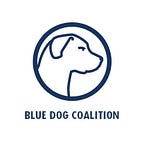Celebrating the 25th Anniversary of the Blue Dog Coalition
Twenty-five years ago, after the Democrats lost the House majority for the first time in 40 years, 23 members of the House Democratic Caucus held a press conference to announce that they had formed a member-driven organization, comprised of Democrats who would be a consistent voice for middle-of-the-road, commonsense policies in Washington. They called themselves the Blue Dog Coalition, having chosen the Blue Dog as a sign of their independence from leadership of both parties, contrary to blind party loyalty.
At the time of the group’s formation, its members said they felt “choked blue” by the extremes of both parties. They viewed the Coalition as a means to counter the liberal wing that had taken over the Democratic Party, providing a platform for the sensible center that had been ostracized. Although it was viewed to be risky to work with the opposite political party, the founding members of Blue Dogs reached across the aisle to work with the Republican majority to get things done for their constituents.
Rather than base its identity on ideology, members of the Blue Dog Coalition decided they would unite around a shared pragmatic approach to governance and two main policy principles: fiscal responsibility and a strong national defense. Over time, that policy focus would expand to other issues, including regulatory improvement, job creation, and government reform. The decision to make the Blue Dog Coalition a policy caucus rather than an ideological one has proven to be key to the group’s survival.
Over the past two decades, the Coalition’s ranks have expanded and dwindled based on the electoral successes and failures of House Democrats. Since 1995, the Democrats have held the House majority for three Congresses. During each of those Congresses, the Coalition’s ranks made a difference, proving that the path to a Democratic majority runs through the Blue Dogs.
The Blue Dogs have established themselves to be not only majority makers, but also “an influential player on major legislation,” according to political scientist Susan Webb Hammond. Whether in the majority or the minority, the Blue Dogs have consistently advocated for bipartisan policies that can produce meaningful change and survive the political pendulum swings in Washington. Their policy accomplishments over the years range from campaign finance reform to fiscal reform to election security.
Throughout the organization’s history, more than 115 Members of Congress, representing districts in 37 states in all regions of the country, from Maine to Hawaii, have joined the Blue Dog Coalition. As America has evolved over the past 25 years, so too has the make-up of the members of the Blue Dog Coalition. In 1995, Democratic swing seats were primarily in rural communities, including areas of the South. Today, Blue Dogs come from not only rural communities, but also suburban-rural and suburban communities. Today’s Blue Dog Coalition reflects the diversity of the country as it is now.
Similar to the founding class, today’s Blue Dog Coalition is midsize, ensuring a level of cohesion on certain policies and ensuring the group holds the number of votes required to influence legislation. Additionally, the Blue Dogs have repositioned themselves to be productive partners with Democratic leadership to help improve legislation prior to a vote, while also continuing to work with their Republican colleagues to produce bipartisan solutions.
The original principles of the Blue Dog Coalition continue to guide the caucus today. They are forever enshrined in the preamble of the organization’s bylaws: “Members of the Blue Dog Coalition are dedicated to the financial stability and national security of the country, notwithstanding partisan political positions and personal fortune and do hereby agree to organize a Coalition to serve the interests of our country.”
